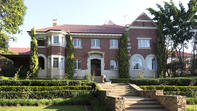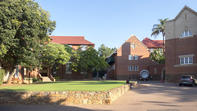South African War
Pretoria Boys' High School has its origins in the Staatsmodelskool, built by the government of the South African Republic in the 1880s on the corner of Skinner and Van der Walt streets, now on the edge of Tshwane.

The school operated for only a short time until the South African War broke out in 1899 and within days the teachers and older boys had left to join the commandos; the younger boys returned to their homes.
A use was soon found for the empty building: it was turned into a prison for captured British officers - one of which was Winston Churchill. The Staatsmodelskool achieved unexpected fame when Churchill escaped and the story made headlines in English-language newspapers worldwide. Pretoria High School found it difficult to shake off the romantic heroism of its beginnings, and it was not until it moved premises that the school could feel secure in its reputation as an educational institution rather than as a tourist attraction.
Lord Milner's Administration
When the British marched into Pretoria in June 1900 and secured the release of the officer inmates of the Staatsmodelskool, it seemed that the war was nearly over. However, too many people vastly underestimated the resilience and stubbornness of the Boers, who began a guerilla war that almost brought the British army to its knees; few imagined that the war would drag on for nearly two more years. In Tshwane, meanwhile, life went on: British military and civil administration was soon in place; businessmen moved into the city, and wives and children soon arrived to join the men.
Education was high on the agenda of Lord Milner's administration, and a school for the sudden influx of English-speaking children became a top priority. The old Staatsmodelskool building met the immediate needs quite admirably and was quickly refurbished, renamed Pretoria High School and pressed into service as the first 'Milner school' in the Transvaal. While an ex prison building might seem a particularly lowly beginning, it was on a par with what served as schoolrooms in Johannesburg for other Milner schools there: home to the precursor of Jeppe High School for Boys was a rented house in the suburb of Fairview, and the institution destined to be one of the country's great educational successes - King Edward VII School - opened its doors to seven pupils in a disused cigar factory at the corner of Kerk and Goud streets in the Johannesburg city centre.
The New School Opened

The new school opened in 1901 under headmaster Charles Hope, a former master of Bishops and St Andrew's College in the Cape. The initial enrolment was just 14 pupils - both boys and girls - but this increased rapidly and by the end of August of that year had reached 132. Hope stayed for only 15 months before leaving in January 1903 to open the next of the Milner schools, Jeppestown High School for Boys and Girls.
From there he went on to found yet another Milner school, in Potchefstroom, over which he presided for 15 years. Coinciding with his departure from Pretoria High School, the girls' component was separated and moved into the premises of the old Staatsmeisieskool, renamed the Pretoria High School for Girls. (These premises are now home to the Hamilton Primary School.)
The remaining boys' classes were split into a primary and high school, and operated as separate schools under one roof until the end of 1905, when the primary school moved into its own building nearby.
Hope's successor was Harold W Atkinson, newly arrived from England. With the departure of the girls and the separation of the junior boys enrolment had fallen to 84, but it increased steadily over the next few years. The staff under Atkinson consisted of William Falcon, Mr CP Hill (later of King Edward VII School, and killed in the First World War), and Mr West, a young Oxford graduate who soon afterwards contracted typhoid fever and died. He was replaced by Desmond Davis, who would later become the longest-serving and much-loved headmaster of King Edward VII School in Johannesburg.
By the end of 1903 enrolment had reached a respectable 100 and, with two new masters added to the staff, the school - which had become known as Pretoria College - was firmly established. Atkinson left at the end of 1905, being succeeded at the beginning of 1906 by JF Acheson, who stayed at the helm for the remainder of the school's time in its Skinner Street home.
Primary Education
Primary education was not the only concern of the Milner administration, however. Plans had also been put into action for the development of a system of secondary and tertiary education in Tshwane, and the government had set aside about 200 ha of land to the southeast of the then built-up area of Tshwane for this purpose.
First on the list of land and building priorities was a new school for the Pretoria High School for Boys. For this 60 ha in the southern portion of the 200 ha was set aside; half the allocated site was fairly level, but to the south it sloped steeply up to the top of Waterkloof Kop.
The chief architect of the Transvaal Department of Public Works, Mr Tyrwhitt, was one of the band of talented men that became known as the Milner Kindergarten. Hand-picked in Britain and brought to South Africa, these were the people on whose shoulders rested the responsibility of getting the wheels of post-war government, commerce and industry in South Africa turning again.
To Tyrwhitt was entrusted the drawing up of the plans for the new school building - and he met the challenge admirably, producing what is considered by many to be one of the grandest examples of school architecture in the country. Designed in the English Classical Revival style, Pretoria Boys' High School is a fitting counterpoint to the Union Buildings, which face it from the opposite side of Tshwane.